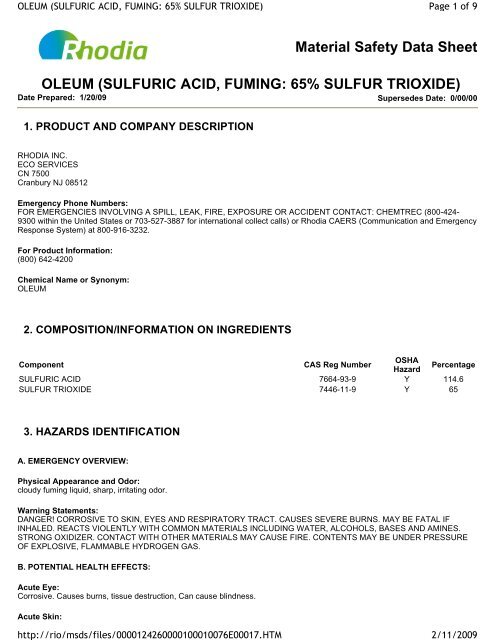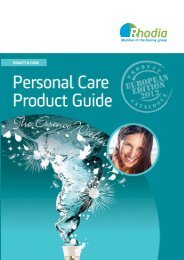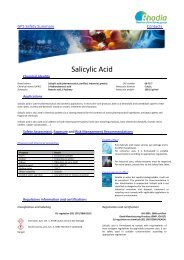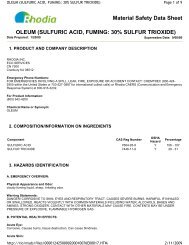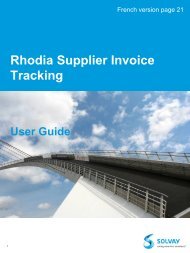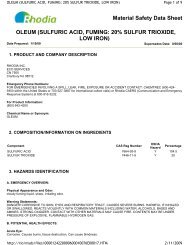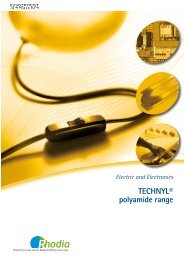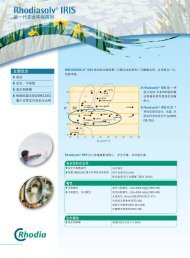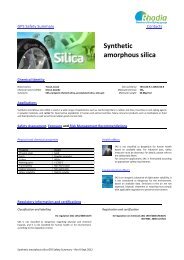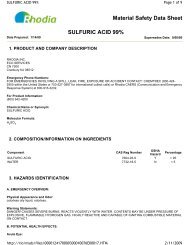Oleum 65 - Rhodia
Oleum 65 - Rhodia
Oleum 65 - Rhodia
You also want an ePaper? Increase the reach of your titles
YUMPU automatically turns print PDFs into web optimized ePapers that Google loves.
OLEUM (SULFURIC ACID, FUMING: <strong>65</strong>% SULFUR TRIOXIDE)http://rio/msds/files/0000124260000100010076E00017.HTMPage 1 of 92/11/2009 Material Safety Data Sheet OLEUM (SULFURIC ACID, FUMING: <strong>65</strong>% SULFUR TRIOXIDE)Date Prepared: 1/20/09 Supersedes Date: 0/00/001. PRODUCT AND COMPANY DESCRIPTIONRHODIA INC.ECO SERVICESCN 7500Cranbury NJ 08512Emergency Phone Numbers:FOR EMERGENCIES INVOLVING A SPILL, LEAK, FIRE, EXPOSURE OR ACCIDENT CONTACT: CHEMTREC (800-424-9300 within the United States or 703-527-3887 for international collect calls) or <strong>Rhodia</strong> CAERS (Communication and EmergencyResponse System) at 800-916-3232.For Product Information:(800) 642-4200Chemical Name or Synonym:OLEUM2. COMPOSITION/INFORMATION ON INGREDIENTSComponentCAS Reg NumberOSHAHazardPercentageSULFURIC ACID 7664-93-9 Y 114.6SULFUR TRIOXIDE 7446-11-9 Y <strong>65</strong>3. HAZARDS IDENTIFICATIONA. EMERGENCY OVERVIEW:Physical Appearance and Odor:cloudy fuming liquid, sharp, irritating odor.Warning Statements:DANGER! CORROSIVE TO SKIN, EYES AND RESPIRATORY TRACT. CAUSES SEVERE BURNS. MAY BE FATAL IFINHALED. REACTS VIOLENTLY WITH COMMON MATERIALS INCLUDING WATER, ALCOHOLS, BASES AND AMINES.STRONG OXIDIZER. CONTACT WITH OTHER MATERIALS MAY CAUSE FIRE. CONTENTS MAY BE UNDER PRESSUREOF EXPLOSIVE, FLAMMABLE HYDROGEN GAS.B. POTENTIAL HEALTH EFFECTS:Acute Eye:Corrosive. Causes burns, tissue destruction, Can cause blindness.Acute Skin:
http://rio/msds/files/0000124260000100010076E00017.HTM2/11/2009OLEUM (SULFURIC ACID, FUMING: <strong>65</strong>% SULFUR TRIOXIDE)Page 3 of 9INGESTION: If not already performed by first aid personnel, irrigate mouth with large amounts of water and dilute the acid byhaving victim drink 4 to 8 ounces of water or milk. DO NOT induce vomiting. Use of gastric lavage is controversial. Theadvantage of removal of acid must be weighted against the risk of perforation or bleeding. If a large amount of acid (> 1 ml/kgbody weight) has been recently ingested, cautious gastric lavage is generally advised if the patient is alert and there is little riskof convulsions. Consultation with a gastroenterologist and/or surgeon is advised. Serious complications such as perforation orstricture of the esophagus may occur requiring care by specialists. Laryngeal edema may develop requiring intubation ortracheostomy.5. FIRE FIGHTING MEASURESFIRE HAZARD DATA:Flash Point:Not ApplicableExtinguishing Media:Not combustible. Use extinguishing method suitable for surrounding fire. Recommended (small fires): dry chemical, carbondioxide, Recommended (large fire): dry sand, water spray (massive amount), Not recommended: water (unless large excess ispossible).Special Fire Fighting Procedures:Firefighters should wear NIOSH/MSHA approved positive pressure breathing apparatus with full face-piece and full acidresistantprotective clothing. Fight fire from maximum distance.Unusual Fire and Explosion Hazards:Not combustible. Strong oxidizers can react with reducing agents or combustibles producing heat and causing ignition. Reactsviolently with water releasing heat and corrosive material. The addition of water into a ruptured tank may cause an explosion andthe formation of a thick cloud of corrosive, highly toxic smoke capable of travelling long distances.Hazardous Decomposition Materials (Under Fire Conditions):oxides of sulfur6. ACCIDENTAL RELEASE MEASURESEvacuation Procedures and Safety:Personnel handling this material should be thoroughly trained to handle spills and releases. Do not direct hose streams into anunignited transportation spill (tank truck or tank car).Containment of Spill:Stop leak if it can be done without risk. Dike spill using absorbent or impervious materials such as earth, sand or clay. Dike orretain dilution water or water from firefighting for later disposal.Cleanup and Disposal of Spill:Pump any free liquid into an appropriate closed container (see Section 7: Handling and Storage). Exercise caution duringneutralization as considerable heat may be generated. Neutralize spill area with soda ash, sodium bicarbonate or lime.Environmental and Regulatory Reporting:Do not flush to drain. Runoff from fire control or dilution water may cause pollution. Dispose of as a hazardous waste. Spills maybe reportable to the National Response Center (800-424-8802) and to state and/or local agencies. Large spills should behandled according to a predetermined plan. For assistance in developing a plan contact the Technical Service Department usingthe Product Information phone number in Section 1.7. HANDLING AND STORAGE
OLEUM (SULFURIC ACID, FUMING: <strong>65</strong>% SULFUR TRIOXIDE)http://rio/msds/files/0000124260000100010076E00017.HTMPage 4 of 92/11/2009Minimum/Maximum Storage Temperatures:Not AvailableHandling:Do not breathe vapors and mists. Do not get on skin or in eyes. This product reacts violently with bases liberating heat andcausing spattering.When diluting an acid, ALWAYS add the acid slowly to water and stir well to avoid spattering. NEVER ADD WATER TO ACID.Storage:Store in tightly closed containers. Store in an area that is dry, well-ventilated, Expected shelf life if stored at recommendedtemperature (4C) : 6 months. Freezing point varies with concentration. Maximum recommended storage temperature = 104F(40C). Corrosion rates increase at elevated temperatures.8. EXPOSURE CONTROLS/PERSONAL PROTECTIONIntroductory Remarks:These recommendations provide general guidance for handling this product. Because specific work environments and materialhandling practices vary, safety procedures should be developed for each intended application. While developing safe handlingprocedures, do not overlook the need to clean equipment and piping systems for maintenance and repairs. Waste resulting fromthese procedures should be handled in accordance with Section 13: Disposal Considerations.Assistance with selection, use and maintenance of worker protection equipment is generally available from equipmentmanufacturers.Exposure Guidelines:Exposure limits represent regulated or recommended worker breathing zone concentrations measured by validated samplingand analytical methods, meeting the regulatory requirements. The following limits apply to this material, where, if indicated,S=skin and C=ceiling limit:SULFURIC ACIDACGIHOSHARHODIANotes TWA STEL0.2 mg/cu m1 mg/cu m0.3 mg/cu mEngineering Controls:Where engineering controls are indicated by use conditions or a potential for excessive exposure exists, the following traditionalexposure control techniques may be used to effectively minimize employee exposures: local exhaust ventilation at the point ofgeneration.Respiratory Protection:When respirators are required, select NIOSH/MSHA approved equipment based on actual or potential airborne concentrationsand in accordance with the appropriate regulatory standards and/or industrial recommendations.If the exposure limit is exceeded and engineering controls are not feasible, a full facepiece respirator with an acid gas cartridgeand particulate filter (NIOSH type N100 filter) may be worn up to 50 times the exposure limit, or the maximum use concentrationspecified by the appropriate regulatory agency or respirator supplier, whichever is lowest. If oil particles (e.g. lubricants, cuttingfluids, glycerine, etc.) are present, use a NIOSH type R or P particulate filter. WARNING: Air purifying respirators do not protectworkers in oxygen-deficient atmospheres. For emergencies or instances where the exposure levels are not known, use a fullfacepiecepositive-pressure, air-supplied respirator.Eye/Face Protection:Eye and face protection requirements will vary dependent upon work environment conditions and material handling practices.Appropriate ANSI Z87 approved equipment should be selected for the particular use intended for this material. Contact to faceand eyes should be prevented through use of a face shield and splash proof goggles. An emergency eye wash must be readilyaccessible to the work area.Skin Protection:
http://rio/msds/files/0000124260000100010076E00017.HTM2/11/2009OLEUM (SULFURIC ACID, FUMING: <strong>65</strong>% SULFUR TRIOXIDE)Page 5 of 9Skin contact must be prevented through the use of permeation resistant clothing, gloves and footwear, selected with regard foruse conditions and exposure potential. An emergency shower must be readily accessible to the work area. Consideration mustbe given both to durability as well as permeation resistance.Work Practice Controls:Personal hygiene is an important work practice exposure control measure and the following general measures should be takenwhen working with or handling this material:(1) Do not store, use, and/or consume foods, beverages, tobacco products, or cosmetics in areas where this materialis stored.(2) Wash hands and face carefully before eating, drinking, using tobacco, applying cosmetics, or using the toilet.(3) Wash exposed skin promptly to remove accidental splashes or contact with this material.9. PHYSICAL AND CHEMICAL PROPERTIESPhysical and Chemical properties here represent typical properties of this product. Contact the business area using the ProductInformation phone number in Section 1 for its exact specifications.Physical Appearance:cloudy fuming liquid.Odor:sharp, irritating odor.pH:< 1 at 1 wt/wt%.Specific Gravity:1.992 at 4 C (39 F).Water Solubility:miscibleMelting Point Range:Not AvailableFreezing Point Range:1 C (34 F)Boiling Point Range:<strong>65</strong> C (149 F) at mmHgVapor Pressure:78.76 mmHg at 20 C (68 F)Vapor Density:Not Available10. STABILITY AND REACTIVITYChemical Stability:This material is stable under normal handling and storage conditions described in Section 7.Conditions To Be Avoided:water
OLEUM (SULFURIC ACID, FUMING: <strong>65</strong>% SULFUR TRIOXIDE)http://rio/msds/files/0000124260000100010076E00017.HTMPage 6 of 92/11/2009Materials/Chemicals To Be Avoided:waterstrong reducing agentshalogensbasesmetalsnitrogen compoundsThe Following Hazardous Decomposition Products Might Be Expected:Decomposition Type: thermaloxides of sulfurHazardous Polymerization Will Not Occur.Avoid The Following To Inhibit Hazardous Polymerization:not applicable11. TOXICOLOGICAL INFORMATIONAcute Eye Irritation:The following data are for similar or related products.Toxicological Information and Interpretation:eye - eye irritation, 250 ug/24 hr, rabbit. Severely irritating. Data for sulfuric acid.Acute Skin Irritation:No test data found for product. This product was not tested because strong acids are known to be corrosive and to cause severetissue destruction.Acute Dermal Toxicity:No test data found for product. This product was not tested because strong bases are known to be corrosive and to causesevere tissue destruction.Acute Respiratory Irritation:The following data is for similar or related products.Toxicological Information and Interpretation:lung - lung irritation, < 5 mg/cu m, human. Mildly irritating. Data for sulfuric acid.Acute Inhalation Toxicity:The following data is for similar or related products.Toxicological Information and Interpretation:LC50 - lethal concentration 50% of test species, 347 ppm/1 hr, rat. Data for sulfuric acid.LC50 - lethal concentration 50% of test species, 510 mg/cu m/2 hr, rat. Data for sulfuric acid.Acute Oral Toxicity:The following data is for similar or related products.Toxicological Information and Interpretation:LD50 - lethal dose 50% of test species, 2140 mg/kg, rat. Data for sulfuric acid.Chronic Toxicity:This product contains the substances that are considered to be "probable" or "suspected" human carcinogens as follows:The International Agency for Research on Cancer (IARC) and the National Toxicology Program (NTP) have classified"occupational exposure to strong inorganic acid mists containing sulfuric acid" as a known human carcinogen (IARC Category1). This classification applies only to sulfuric acid when generated as a mist. There is still debate in the scientific communitywhether the studies reviewed by IARC and NTP adequately controlled for confounding occupational exposures and personalhabits such as cigarette smoking and alcohol consumption. A few epidemiology studies have suggested a possible associationbetween sulfuric acid exposure and laryngeal or lung cancer; however, in all these studies, workers were exposed to many otherchemicals, some of which are recognized carcinogens, such as diethylsulfate and nickel. Considering the multiple chemical
http://rio/msds/files/0000124260000100010076E00017.HTM2/11/2009OLEUM (SULFURIC ACID, FUMING: <strong>65</strong>% SULFUR TRIOXIDE)Hazard Class..... 8Shipping Name:SULFURIC ACID, FUMINGID Number....... UN1831Packing Group.... ILabels........... CORROSIVE, POISONEmergency Guide #.... 137Page 8 of 915. REGULATORY INFORMATIONInventory StatusInventory StatusUNITED STATES (TSCA)YCANADA (DSL)YEUROPE (EINECS/ELINCS)YAUSTRALIA (AICS)YJAPAN (MITI)YSOUTH KOREA (KECL)YY = All ingredients are on the inventory.E = All ingredients are on the inventory or exempt from listing.P = One or more ingredients fall under the polymer exemption or are on the no longer polymer list. All other ingredients are onthe inventory or exempt from listing.N = Not determined or one or more ingredients are not on the inventory and are not exempt from listing.FEDERAL REGULATIONSInventory Issues:All functional components of this product are listed on the TSCA Inventory.SARA Title III Hazard Classes:Fire HazardReactive HazardRelease of PressureAcute Health HazardChronic Health Hazard- NO- YES- NO- YES- NOSARA 313 ChemicalsSULFURIC ACID (114.6%)SARA Extremely Hazardous Substances (EHS)/CERCLA Hazardous SubstancesIngredient CERCLA/SARA RQ SARA EHS TPQSULFURIC ACID 1000 lbs 1000 lbsSULFUR TRIOXIDE100 lbsUNLISTED HAZARDOUS WASTES - CHARACTERISTIC OFCORROSIVITY100 lbsUNLISTED HAZARDOUS WASTES - CHARACTERISTIC OF REACTIVITY 100 lbsSTATE REGULATIONS:This product contains the following components that are regulated under California Proposition <strong>65</strong>:Ingredient Name Cancer Reprod. No Sign. Risk Lvl (ug/day)List List California RPIOCCUPATIONAL EXPOSURES TO STRONG-INORGANIC-AC ID MISTS CONTAINING SULFUY N ND ND
OLEUM (SULFURIC ACID, FUMING: <strong>65</strong>% SULFUR TRIOXIDE)http://rio/msds/files/0000124260000100010076E00017.HTMPage 9 of 92/11/200916. OTHER INFORMATIONNational Fire Protection Association Hazard Ratings--NFPA(R):3 Health Hazard Rating--Serious0 Flammability Rating--Minimal2 Instability Rating--Moderate0 * NO WATERNational Paint & Coating Hazardous Materials Identification System--HMIS(R):3 Health Hazard Rating--Serious0 Flammability Rating--Minimal2 Reactivity Rating--ModerateReason for Revisions:New product MSDS.Key Legend Information:ACGIH - American Conference of Governmental Industrial HygienistsOSHA - Occupational Safety and Health AdministrationTLV - Threshold Limit ValuePEL - Permissable Exposure LimitTWA - Time Weighted AverageSTEL - Short Term Exposure LimitNTP - National Toxicology ProgramIARC - International Agency for Research on CancerND - Not determinedRHODIA - <strong>Rhodia</strong> Established Exposure LimitsDisclaimer:The information herein is given in good faith but no warranty, expressed or implied, is made.** End of MSDS Document **


